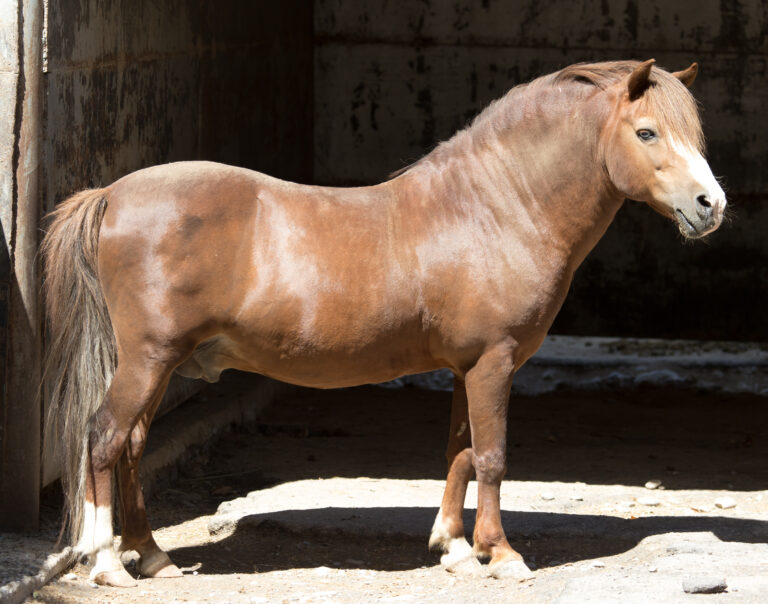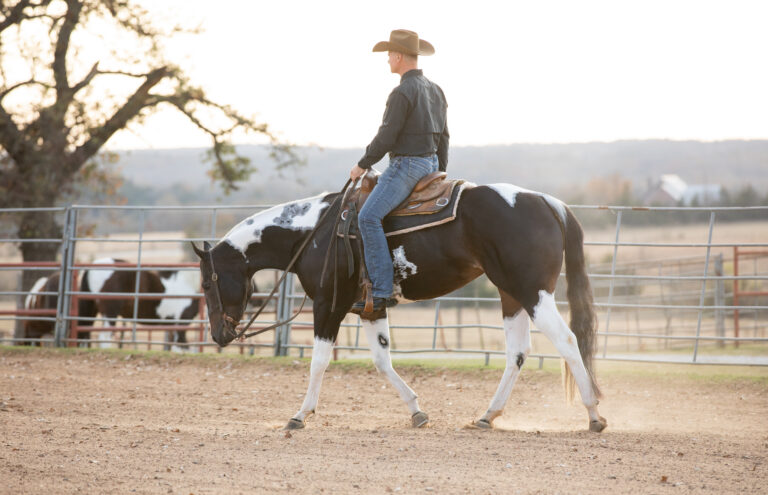
It is not unusual for veterinarians to hear rider complaints about a horse’s back soreness or poor performance that might be associated with back pain.
In a study out of Colorado State University’s (CSU) Equine Orthopedic Research Center, researchers evaluated the clinical relationship between equine limb lameness and secondary back dysfunction. The study involved 36 horses split into three groups of 12: sound, forelimb lame, and hind-limb lame. The researchers used ultrasound to measure each horse’s multifidus muscle cross-sectional area at multiple spinal levels. The results indicate the cross-sectional area of the multifidus muscle at all levels was significantly larger in sound horses than the forelimb lame group, regardless of side. This supports the premise that axial skeletal adaptation occurs in response to naturally occurring chronic lameness and that forelimb lameness is associated with decreased cross-sectional area of the multifidus muscles.
In a webinar sponsored by Platinum Performance, CSU’s Melissa King, DVM, PhD, Dipl. ACVSMR, addressed the importance of equine core fitness in helping stabilize the spine for effective and pain-free movement.
Why Is Core Fitness Important for Horses?

Core fitness benefits many equine locomotor structures: Abdominal muscles, the axial skeleton, the neck, pelvis, thoraco-lumbar spine, and all stabilizing muscles, such as the multifidus, sublumbar, abdominal, and cervical-thoracic muscles.
King explained that while the multifidus is only one of many core stabilizers, it is the primary stabilizer of the vertebral column. As it runs along both sides of the spine, it has superficial and deep branches and fascicles that connect with each vertebral segment. Human research cites that 25% of people are more likely to experience significant injury if their core is weak prior to undertaking athletic efforts.
The cross-sectional size of the equine multifidus, King said, correlates with equine lameness as referenced in the aforementioned study. It also provides for spinal stability and strength gains. Pathology that decreases the multifidus’ cross-sectional area tends to correlate with a specific area of injury within that anatomical part. With less stability and subsequent excessive motion in that region, the multifidus cannot provide its normal stabilizing function, so the spine relies on other muscles that don’t take on that role normally. The weaker the horse’s core, the more work larger dynamic muscles must assume during that time, with the potential for injury.
Once the multifidus muscle group develops atrophy, King said it takes a long time to regain proper conditioning of core musculature. She stressed that conditioning is not just about legging up; it depends on core fitness and spinal musculature strength.
Examining the Horse
When evaluating the horse, King emphasized the importance of analyzing the entire animal, not just the distal limb. To optimize performance, she recommends riders take the necessary time to develop a horse’s dynamic condition under saddle while strengthening static core muscles when not under saddle. A veterinarian’s role is to perform a functional assessment and dynamic exam of the horse under saddle, especially when engaged in sport-specific activities the rider wishes to pursue. Consider how well the horse’s muscles are firing with a given task and the horse’s range of motion. Is there resistance, or are the gaits smooth and gliding? Another question to ask the rider is whether they train for their specific level of competition at home, so the horse’s body is prepared for that level of effort.
As a general rule, in humans it takes four weeks for muscles to atrophy but double that time to regain strength. If a horse is laid up for a month, it is common to expect an eight- to 12-week duration to restore muscle strength with appropriate conditioning and strengthening exercises.
Various studies cite that 13-94% of the equine population has back pain. King said treating distal limb pain might resolve secondary back pain but not always. A concept called anthrogenic muscle inhibition might interfere with automatic restoration of muscle function despite pain resolution. Anthrogenic muscle inhibition describes what happens in the presence of joint pain: Muscle function and activation might be inhibited, thereby limiting the success of an equine rehabilitation program. The horse continues with muscle weakness and atrophy due to failed muscle activation. King stressed that it is important, especially in the initial healing phases, to improve voluntary muscle activation.
Core Fitness Exercises for Horses

To develop and improve core fitness, King recommended veterinarians maintain a close relationship with a team of support people, such as a physiotherapist, farrier, nutritionist, acupuncturist, and chiropractor. One useful reference she suggested is the book Activate Your Horse’s Core, by Dr. Hilary Clayton.
Tailor exercises for each individual horse. King cautioned against repeating exercises more than four or five days per week, because too much effort can be counterproductive and end up reducing strength gains. Examples of strength-building core fitness exercises include:
- Cervical range-of-motion exercises to improve multifidus muscle strength in the thoraco-lumbar area. These include baited carrot stretches to have the horse reach chin to stifle, hock, girth, or chest.
- Sternal lifts to stimulate thoracic sling muscles and abdominal muscles.
- Tail pulls help to elicit isometric contractions so the abdominal, stifle, and thigh muscles produce tension without moving.
- Balance pads that horses stand on to activate proprioception and balance through micro-adjustments by small postural muscles and stability of core muscles.
- TheraBand resistance to recruit lumbo-sacral flexion and abdominal muscles.
- Ground poles to help lift the horse’s back and activate core abdominal muscles.
King described a link between core fitness and proprioception/balance. She recommended using the TheraBand as an excellent stimulus for proprioception. Placing this resistance band around a horse’s hindquarters or abdomen engages the hindquarters along with lumbo-sacral flexion. With increased flexion comes increased range of motion and activation of muscle recruitment to flex the joints via targeted motor output. This also improves spinal stabilization. Such core exercises are valuable to the wellness and development of a budding athlete, she added.
In a study at Michigan State University, researchers reviewed the effect of dynamic stabilization exercises on the multifidus muscles of eight horses over a three-month period. The horses performed three cervical flexions, one cervical extension, and three lateral bending exercises to both sides with five repetitions for each exercise each day for five days a week for three months. They were not ridden during this period. The researchers performed ultrasound of the cross-sectional area of the right and left multifidus muscles at six levels between T10 and L5 at the start and end of the study. The results demonstrated significant increases in multifidus cross-sectional areas at all levels on both sides from three months of dynamic exercises. In addition, any asymmetries between the right and left sides diminished over the three-month exercise period.
In Summary
Just because a horse appears muscular, doesn’t mean it has developed core fitness, King noted. There must be balance between muscle size, performance, and fitness. Thanks to the complex interaction of all subsystems, horses require robust development of the cardiovascular system, respiratory tract, thermoregulation, and bone and soft tissue strength—in addition to strong stability provided by a well-developed core fitness strategy—for optimal performance.
References
- Sullivan HM, Acutt EV, Barrett MF, et al. Influence of Chronic Lameness on Thoracolumbar Musculus Multifidus Structure in the Horse. Journal of Equine Veterinary Science Oct 2022; doi: 10.1016/j.jevs.2022.104053
- Stubbs NC, Kaiser LJ, Hauptman J, Clayton HM. Dynamic mobilization exercises increase cross-sectional area of musculus multifidus. Equine Vet J. 2011 Sep;43(5):522-9. doi: 10.1111/j.2042-3306.2010.00322.
Related Reading
- Disease Du Jour: Back Pain Management in Performance Horses
- Managing Lumbosacroiliac Joint Region Pain in Horses
- Approach to Horses with Poor Performance
Stay in the know! Sign up for EquiManagement’s FREE weekly newsletters to get the latest equine research, disease alerts, and vet practice updates delivered straight to your inbox.

![[Aggregator] Downloaded image for imported item #18965](https://s3.amazonaws.com/wp-s3-equimanagement.com/wp-content/uploads/2025/11/26161444/EDCC-Unbranded-4-scaled-2-768x491.jpeg)
![[Aggregator] Downloaded image for imported item #18808](https://s3.amazonaws.com/wp-s3-equimanagement.com/wp-content/uploads/2025/11/06141153/EDCC-Unbranded-17-scaled-1-768x512.jpg)

